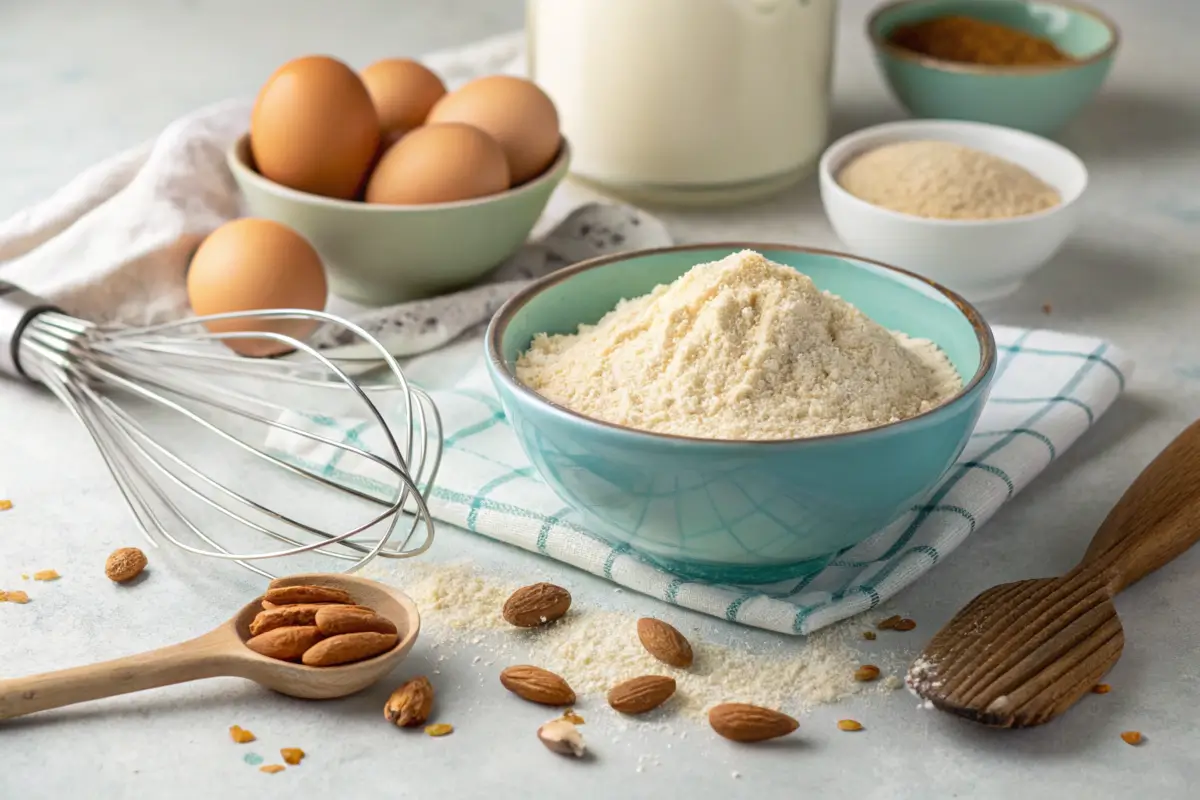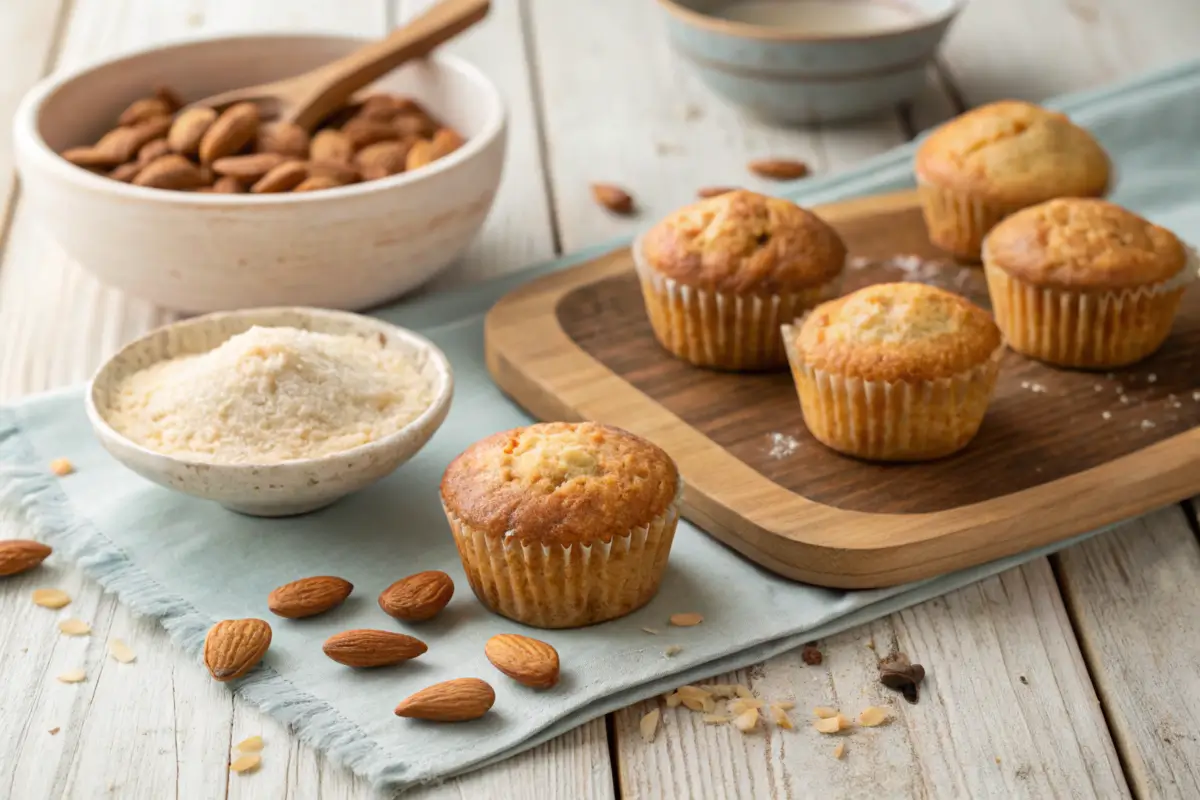Baking with almond flour can feel like stepping into uncharted territory, especially if you’re used to traditional wheat flour. This article dives into the heart of what is the secret to baking with almond flour, unraveling its unique properties and showing you how to master it in your kitchen. From understanding almond flour’s characteristics to troubleshooting common issues, we’ll cover it all. Let’s unlock the magic of almond flour and elevate your baked goods to the next level!
Understanding Almond Flour
What is Almond Flour?
Almond flour is a finely ground flour made from almonds, typically from blanched almonds with the skins removed. It’s known for its nutty flavor and light texture, making it a popular choice for gluten-free and low-carb recipes. Unlike almond meal, which is coarser and includes almond skins, almond flour has a smooth consistency, perfect for delicate baked goods.
Types of Almond Flour: Blanched vs. Unblanched
When it comes to almond flour, you’ll often hear about two main types: blanched and unblanched. Blanched almond flour is made from almonds with the skins removed, resulting in a pale, fine flour ideal for cakes, pastries, and cookies. On the other hand, unblanched almond flour retains the almond skins, giving it a slightly darker hue and a more robust texture. Each type serves different baking purposes, so choosing the right one can make or break your recipe.
Nutritional Benefits of Baking with Almond Flour
One of the reasons almond flour has gained so much popularity is its nutritional profile. Packed with protein, healthy fats, and vitamin E, almond flour is not just tasty but also nutritious. It’s naturally gluten-free and low in carbohydrates, making it a go-to for keto and paleo diets. Plus, its high fiber content supports healthy digestion, giving you an added bonus while indulging in baked treats.
The Unique Characteristics of Almond Flour
Why Almond Flour is Different from Wheat Flour
One of the secrets to baking with almond flour lies in understanding how it contrasts with traditional wheat flour. Almond flour lacks gluten, the protein that gives wheat flour its elasticity. As a result, baked goods made with almond flour don’t hold their shape as firmly and tend to be denser. While this can be a downside for some recipes, it’s perfect for creating moist and tender treats.
Texture and Taste: What to Expect
Almond flour imparts a slightly nutty flavor to recipes, adding depth and richness that wheat flour cannot replicate. Its texture is naturally finer and softer, which enhances the crumb of baked goods like cakes and muffins. However, it can sometimes produce grainy textures if not combined properly with wet ingredients. Choosing the right type of almond flour and blending it well is key to avoiding this issue.
Moisture and Density in Baking
Almond flour is rich in fats, which translates to moist and tender baked goods. However, this can also make recipes overly dense if not balanced with leavening agents or additional dry ingredients. For instance, a bit of coconut flour or tapioca starch can help achieve a lighter texture. Mastering this balance is another critical element of what is the secret to baking with almond flour.
Tips for Baking Success with Almond Flour
Achieving the Right Consistency
Since almond flour is more absorbent than wheat flour, batters and doughs often require adjustments to reach the proper consistency. Adding extra eggs or using a thickener like xanthan gum can improve the structure. For recipes requiring firmness, combining almond flour with another gluten-free flour often does the trick.

How to Prevent Sinking or Crumbling
Almond flour lacks the natural binding properties of gluten, so recipes need a little extra support. Adding an extra egg or a tablespoon of flaxseed meal can help bind ingredients together. Similarly, reducing the baking temperature slightly can prevent the dreaded sinking effect in cakes and muffins.
Importance of Using Eggs or Binders
Eggs are the unsung hero in almond flour recipes. They provide moisture, structure, and leavening, ensuring your baked goods rise properly. If you’re baking vegan, options like chia seeds, aquafaba, or even applesauce can be great substitutes.
Adjusting Oven Temperatures and Times
Because almond flour browns more quickly than wheat flour, lowering the oven temperature by 25°F and extending the bake time slightly can help prevent over-browning. Always keep an eye on your baked goods, as they can turn golden-brown faster than expected.
Recipes and Applications
Best Recipes for Almond Flour: Cakes, Cookies, and Breads
Almond flour shines brightest in baked goods like cakes, cookies, and breads. Its naturally nutty flavor complements desserts such as almond flour chocolate chip cookies or soft vanilla cakes. For bread, almond flour’s density helps create hearty loaves that are perfect for breakfast or snacks. By tweaking the liquid-to-dry ratio, you can transform classic recipes into almond flour masterpieces.
For more inspiration, consider experimenting with almond flour in treats like muffins or scones. If you’re curious about additional recipes, check out this Almond Nut Cake Recipe for a rich, flavorful dessert that highlights almond flour’s versatility.

Low-Carb and Gluten-Free Favorites
Baking with almond flour is a game-changer for anyone following a low-carb or gluten-free lifestyle. Keto recipes, like almond flour pancakes or brownies, are a testament to its flexibility. Its low-carb content and absence of gluten make it ideal for recreating beloved comfort foods without the guilt. Plus, almond flour’s ability to mimic traditional textures ensures these recipes are just as indulgent as their carb-heavy counterparts.
Incorporating Almond Flour in Savory Dishes
While almond flour is famous for sweets, it’s just as effective in savory recipes. From pizza crusts to breading for chicken or fish, its nutty flavor adds a unique twist. For example, using almond flour as a coating for chicken tenders can yield a crispy, golden exterior while keeping the dish gluten-free. The next time you’re craving a savory treat, give almond flour a try—it might just surprise you.
Common Mistakes and How to Avoid Them
Over-Mixing Batter with Almond Flour
One common pitfall when baking with almond flour is over-mixing the batter. Because almond flour contains natural oils, excessive mixing can release these oils, leading to a greasy final product. To avoid this, mix gently and stop as soon as the ingredients are combined. Trust the process—less is often more.
Choosing the Wrong Recipe
Not all recipes adapt well to almond flour. For example, recipes heavily reliant on gluten, like puff pastry, may not work as intended. Instead, focus on recipes designed specifically for almond flour. If you’re unsure where to start, check out almond flour-based dishes like Gipfeli Pastry Tips for innovative ways to make delicate baked goods.
How to Fix Common Baking Issues
When recipes go awry, don’t panic—there are easy fixes. If your almond flour cake is too dense, try adding an extra egg or a pinch of baking soda next time. If it’s too crumbly, a tablespoon of flaxseed meal or xanthan gum can improve the texture. Troubleshooting might take a little trial and error, but it’s part of the learning process. Over time, you’ll master what is the secret to baking with almond flour.
FAQs About Baking with Almond Flour
Why Does Almond Flour Make Baked Goods Dense?
The richness of almond flour, with its natural oils and lack of gluten, often leads to dense baked goods. This density is a result of its high-fat content, which contributes to moisture but can weigh down the batter. To counter this, you can incorporate extra leavening agents like baking powder or baking soda to help the batter rise.
Can Almond Flour Replace Regular Flour 1:1?
While almond flour is versatile, it doesn’t substitute regular flour on a one-to-one basis. Its texture and moisture content require adjustments to other ingredients in the recipe. Typically, almond flour works best as a substitute in recipes already designed for it. For example, you might use 1 cup of almond flour for every 1¼ cups of all-purpose flour, along with additional eggs for structure.
What Is the Best Way to Store Almond Flour?
Proper storage is key to preserving the freshness of almond flour. Store it in an airtight container in a cool, dark place. For longer shelf life, refrigeration or freezing is ideal, as it prevents the natural oils from turning rancid. Always check for a nutty aroma before using—it’s a sign your almond flour is still fresh.
How Can I Make My Almond Flour Recipes Fluffier?
If your almond flour recipes feel heavy, there are a few tricks to lighten them up. Adding an extra egg, a touch of cornstarch, or even folding in whipped egg whites can work wonders. Additionally, avoid over-mixing the batter, as this can release too much oil and weigh it down.
Optimizing Your Kitchen for Almond Flour Baking
Essential Tools for Almond Flour Baking
To unlock what is the secret to baking with almond flour, having the right tools makes a world of difference. Start with a high-quality blender or food processor for sifting and refining almond flour. Silicone baking mats or parchment paper prevent sticking, while non-stick pans ensure easy release. Measuring cups designed for dry ingredients also help maintain precision in your recipes.
Storage Tips for Freshness and Quality
Since almond flour is prone to absorbing moisture and odors, proper storage is non-negotiable. Always use airtight containers, preferably glass, to keep it dry and odor-free. If you bake frequently, dividing almond flour into smaller portions and freezing them ensures you always have fresh flour on hand. Labeling these containers with dates can help track freshness.
Scaling Recipes for Almond Flour
Scaling almond flour recipes requires more than just doubling or halving ingredients. Almond flour’s unique properties mean adjustments must be made to maintain texture and flavor. For larger batches, slightly increase the leavening agents and wet ingredients to achieve consistency. When scaling down, carefully measure to avoid overly dense or dry results.
Advanced Tips for Baking with Almond Flour
Combining Almond Flour with Other Flours
A key part of what is the secret to baking with almond flour is knowing when to mix it with other flours. Combining almond flour with coconut flour, tapioca starch, or oat flour can balance its density and improve the structure of your baked goods. For instance, using a 3:1 ratio of almond flour to coconut flour often creates a perfect harmony of moisture and firmness.
Incorporating Binding Agents for Better Texture
Because almond flour lacks gluten, adding binding agents like eggs, flaxseed meal, or chia seeds is essential to keep your recipes from falling apart. These binders help hold the ingredients together and improve the overall texture. For vegan baking, options like aquafaba or psyllium husk work as excellent substitutes.
Experimenting with Flavor Pairings
Almond flour’s nutty undertones pair beautifully with a range of flavors. From vanilla and cinnamon to lemon and dark chocolate, the possibilities are endless. Don’t hesitate to experiment with spices or extracts to elevate your recipes. Pairing almond flour with citrus zest, for example, can add a refreshing twist to cookies or cakes.
The Science Behind Baking with Almond Flour
How Almond Flour Impacts Texture and Rise
Almond flour’s high fat content and lack of gluten affect how baked goods rise and hold their shape. This is why understanding its unique properties is crucial for mastering what is the secret to baking with almond flour. The natural fats in almond flour make recipes tender and moist but can limit rise, especially in bread and cakes. Adding more leavening agents can counterbalance this effect.
Moisture Retention: A Double-Edged Sword
One of almond flour’s strengths is its ability to retain moisture, which keeps baked goods fresh longer. However, too much moisture can lead to overly dense or soggy textures. To avoid this, reduce the amount of liquid in your recipes or increase the baking time slightly to ensure proper cooking.
Balancing Nutrition and Flavor
Another benefit of almond flour is its nutritional profile, which includes protein, healthy fats, and fiber. However, its rich flavor can sometimes overpower delicate recipes. Balancing almond flour with mild ingredients like rice flour or cornstarch can create a more neutral base for versatile recipes.

